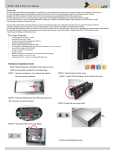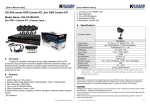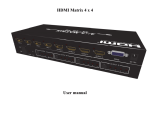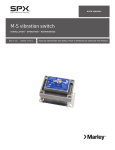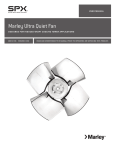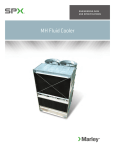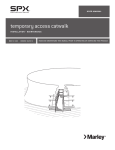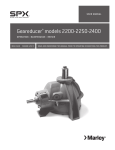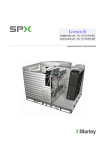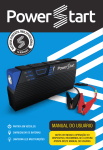Download Marley Liquid Level Control System
Transcript
/ Marley Liquid Level Control System / User Manual 98-1482A 1 Contents Introduction.............................................................................................. 2 Wiring....................................................................................................... 3 Operation.................................................................................................. 4 Troubleshooting........................................................................................ 8 Checkout Procedure—Water Makeup and High Alarm............................ 9 Checkout Procedure—Low Alarm.......................................................... 10 Replacement Parts................................................................................. 11 Specifications......................................................................................... 12 Introduction The Liquid Level Control systems are used to accomplish several functions: •Electronic Water Makeup •Low-water Alarms •Low-water Cutoff •High-water Alarms •High-water Cutoff The most common application is electronic water makeup. This system is used with a remotely installed water solenoid valve to add water to the system as required. Conductivity probes are utilized to electronically monitor the water level. Problems associated with freezing water lines are avoided in a properly designed system by installing all pressurized water lines in a protected environment. Makeup water is added to the cooling system and supplied to the tower through non-pressurized, self draining lines. Low-water and high-water alarms can be utilized to give warnings associated with abnormal operating conditions. The system provides dry contacts to interface with digital control systems or user supplied alarm indicators to signal when corrective action is required. Low-water cutoffs are commonly applied to protect pumps and basin heaters from operating without water thus preventing costly repairs associated with unintended operation. Dry contacts can be wired directly in series with pilot duty controls or to digital control systems to initiate the shutdown of protected equipment during low-water situations. 2 Wiring Make-Up Relay H L 15 14 C 13 Terminal Strip Legend Connection for Outgoing Lines 1 2 3 and 4 3 Note 5 4 2 1 and 2 1 5 6 High Relay H L 16 or 17 C 13 7 8 9 5 and 6 10 11 7 and 8 Note 5 12 2 1 and 2 1 H L 18 or 19 C 13 9 and 10 Note 5 2 1 and 2 1 Make-Up Relay H L 15 14 C 13 SOL 1 High Level Cut-Off Low Level Alarm Low Level Cut-Off 13 Reference Probe 14 Make-Up On Probe 15 Make-Up Off Probe 16 High Alarm Probe 17 High Cut-Off Probe 18 Low Alarm Probe 19 Low Cut-Off Probe Note Diagram shows internal wiring. 2 One relay is required for each alarm or cutoff level. 2 3 Ground screw is provided on the relay panel. 1 4 Relay cards provide dry contacts. Power for alarm signals or solenoid valves must be supplied externally. 5 10 amp resistive load or (1/3 hp @ 120V AC) 3 115VAC High Level Alarm 1 4 2 Water Make-Up Connection for Probe Wiring Low Relay 11 and 12 115 VAC Note 5 115 VAC solenoids connected as shown 3 Operation The Liquid Level Control System consists of special purpose liquid sensing relays connected to a probe assembly located in the cold water basin. The relay cards are powered by a 115 VAC power supply. The relay cards produce a current limited 17.5 VDC signal to detect water level. This current is conducted through the water across probes of dissimilar length. When the water level reaches the shorter probe, the circuit is completed and the relay responds, opening or closing relay contacts corresponding to a fixed level. The longest probe is the ground reference probe, and is shared by all the functions of the system. For low level control, the ground reference probe and a slightly shorter probe provide the circuit. The distance from the tip of this probe to the floor of the basin determines the minimum water level that is allowed before an alarm is produced or pump operation is interrupted. See Figure 1. When the water level drops below this level, the connection between these probes is broken and the relay contacts transfer. 5611 Low Signal 115 VAC H L C NC NO C AC Min. Depth Figure 1 Fill control utilizes two additional probes. The longest of these two probes determines the level at which fill begins, and the shorter probe determines the point at which fill is complete. The fill valve opens when the water level drops below the longer probe, breaking contact between it and the ground reference. The fill valve remains energized until the water level reaches the shorter probe, completing the circuit across this probe and the ground reference. See Figure 2. At this point, the valve is de-energized and closes. 4 Operation 5612 H L C NC NO C Valve Circuit 115 VAC AC Complete Fill Start Figure 2 The high level alarm is provided by the shortest probe and provides warning that the water level is exceeding the proper operational level. This alarm signal is produced when the water makes contact across the shortest probe and the ground reference, and ceases when the water level drops below this level. See Figure 3. 5612 High Signal 115 VAC NC NO C H L C AC High Normal Figure 3 5 Operation All the probes are contained in a single assembly and protected by a sheet metal stilling chamber. The probe assembly is connected to a bracket for mounting in the cold water basin. See Figure 4. All wires are routed to the relay enclosure in a liquid tight conduit. Conduit to be routed so relay box is high point in system and probe holder is low point. Each function, low alarm, water makeup or high alarm, requires a separate relay. All relays are powered by a 115 VAC supply voltage connected to terminals labeled “AC line” on the terminal strip at the bottom of the relay circuit board. Terminals COM, NO and NC provide outputs to alarms or fill valves. Terminals C, L and/or H on the terminal strip at the top of the relay circuit board are connected to the probes. See Figures 1, 2 and 3. Figure 4 6 Operation For a single function system requiring only one relay, the relay is housed in a 6″ x 6″ NEMA 4X enclosure normally mounted on the side of the cooling tower. For two or more functions, relays are located in a 12″ x 14″ NEMA 4X enclosure and all relay wiring is connected to terminal strips located in the enclosure. See Figure 5. AC H L C High Alarm NC NO C AC NC NO C H L C Water Makeup Low Alarm AC NC NO C H L C High Cutoff or Low Cutoff 1 2 3 4 5 6 7 8 9 10 11 12 13 14 15 16 17 18 19 Figure 5 AC Power To Outputs To Probes There are two types of relays used in the system. The two relays appear exactly alike and are identifiable only by the numbers printed on the circuit board. The relay used for low level control is designated TYPE 5611-0000 and is described as direct operation. This means that when power is applied to the relay, the contacts remain in their normal position until the probe circuit is completed across C (ground reference) and L (low) at which time the contacts transfer. The relay used for fill control and high level alarm is designated TYPE 5612-0000 and is described as inverse operation. The contacts operate the opposite of direct operation, transferring when power is applied to the relay and returning to their normal position when the probe circuit across C and H is completed. 7 Troubleshooting Trouble Probable Cause Remedy Tower Basin Overflows 1. Faulty Sol. Valve 2. Faulty Fill Relay (See Checkout Procedure.) 3. Deposits (Plating) on Probes 4. Low Liquid Conductivity (de-mineralized water, etc.) 1. Faulty Sol. Valve 2. Faulty Fill Relay (See Checkout Procedure.) 3. Contamination (foam) in Stilling Chamber 1. Contamination (foam) in Stilling Chamber 1. Replace Valve. 2. Replace Relay. Low Water Level Low Level Alarm Fails False High Water Alarm False Low Water Alarm 1. Contamination (foam) in Stilling Chamber 2. Faulty High Alarm Relay (See Checkout Procedure.) 1. Faulty Low Alarm Relay (See Checkout Procedure.) 3. Clean Probes. 4. Contact Marley. 1. Replace Valve. 2. Replace Relay. 3. Clean Stilling Chamber. 1. Clean Stilling Chamber. 1. Clean Stilling Chamber. 2. Replace Relay. 1. Replace Relay. Note: Checkout procedure for relay circuit boards is provided on pages 9 and 10. 8 Checkout Procedure 5612-0000 Relay — Water Makeup and High Alarm Circuits 0 H Load Contacts NC L NO C COM 115 VAC 0 H Load Contacts Probes NC L NO C Probes COM 115 VAC AC Line AC Line Step1 Step 2 1—Disconnect all wires from relay card. Connect power to the relay. 1. Attach a jumper to C and L (probe terminals). Meter should still read 0 ohms. 2—Connect ohmmeter across contacts COM and NO. Meter should read 0 ohms (closed contact). H infinity Load Contacts NC L NO C COM 115 VAC 0 H Load Contacts Probes NC L NO C COM 115 VAC AC Line Probes AC Line Step 3 Step 4 1. Touch a jumper to the H and C terminals. Meter should read “infinity” (open contact). 1. Remove the jumper from L to C. Meter should read 0 ohms, indicating contacts have closed. 2. Remove the jumper from H to C, leaving the jumper from L to C in place. Contacts should remain open. Note—Check out procedure for 5212 relay uses normally open contacts, verses normally closed for 5611. See page 10. 9 Checkout Procedure 5611-0000 Relay — Low Alarm Circuit 0 H Load Contacts NC L NO C COM 115 VAC 0 H Load Contacts Probes NC L NO C Probes COM 115 VAC AC Line AC Line Step1 Step 2 1—Disconnect all wires from relay card. Connect power to the relay. 1. Attach a jumper to C and L (probe terminals). Meter should still read 0 ohms. 2—Connect ohmmeter across contacts COM and NC. Meter should read 0 ohms (closed contact). infinity Load Contacts H NC L NO C COM 115 VAC 0 H Load Contacts Probes NC L NO C COM 115 VAC AC Line Probes AC Line Step 3 Step 4 1. Touch a jumper to the H and C terminals. Meter should read “infinity” (open contact). 1. Remove the jumper from L to C. Meter should read 0 ohms, indicating contacts have closed. 2. Remove the jumper from H to C. Contacts should remain open. Note—Check out procedure for 5211 relay uses normally closed contacts, verses normally opened for 5612. See page 9. 10 Replacement Parts 1 2 5 AC NC NO C AC H L C High Alarm AC H L C Low Alarm NC NO C 4 NC NO C H L C Water Makeup High Cutoff or Low Cutoff 3 1 2 3 4 5 6 7 8 9 10 11 12 13 14 15 16 17 18 19 1—4 x 4 Box Cover...................................................................................................... C32349D 2—4 x 4 Gasket............................................................................................................ C32350D 3—Sensor..................................................................................................................... C745160 4—BW Relay 5611-0000, Low Alarm or Low Cutoff.................................................... A87493D 5—BW Relay 5612-0000, High Alarm, High Cutoff or Makeup................................... A87492D 11 Specifications .187" SLOT, 2 PLACES 4.0" 3.87" 3.16" 1.5" 3.0" PC BOARD 1.25" Series 56 Relay 1.72" PVC SNAP-IN MOUNTING TRACK NET WEIGHT 7.25 OUNCES Voltage: 120 Volts AC, 50/60 Hertz 240 Volts AC, 50/60 Hertz. Other voltages available on special order. Power Required: 4 Volt-amperes, 2 watts. Load Contacts: Single pole, double throw. Gold-flashed silver cadmium oxide. Contact Ratings: 10 amperes resistive load or 1/3 hp at 120 Volts AC; 6 amperes resistive load at 240 Volts AC or 28 Volts DC. Sensing Circuit: 17.5 Volts DC open circuit; 400 microamperes short circuit. Includes a lock-in feature for greater versatility. Sensitivity: 50,000 ohms/cm fixed is standard. Other sensitivities, fixed or adjustable, are available on special order. 7401 WEST 129 STREET | OVERLAND PARK, KANSAS 66213 UNITED STATES | 913 664 7400 | [email protected] | spxcooling.com In the interest of technological progress, all products are subject to design and/or material change without notice. ©2009 SPX Cooling Technologies, Inc. | Printed in USA Manual 98-1482A












